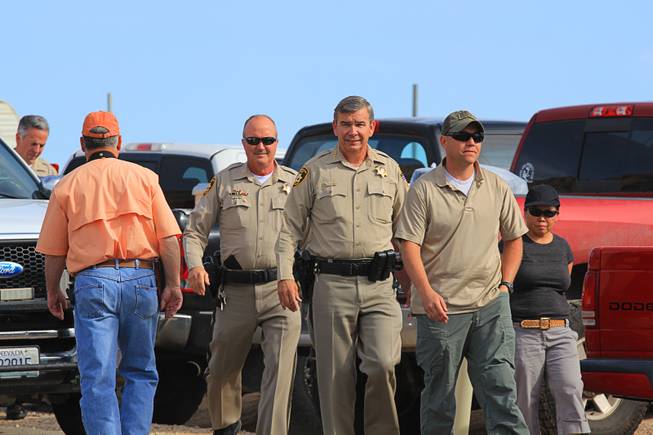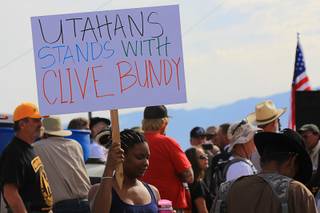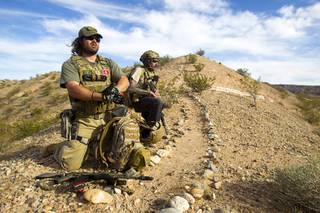
Shannon Bushman
Sheriff Doug Gillespie, center, arrives at a meeting of Cliven Bundy supporters before the April 12, 2014 stand-off between the Bureau of Land Management and supporters of rancher Cliven Bundy near Bunkerville, Nevada. The BLM eventually called off their roundup of Bundy cattle citing safety concerns. Courtesy of Shannon Bushman.
Wednesday, July 2, 2014 | 5:38 p.m.
Three months after he helped broker an end to a standoff between federal agents and self-ascribed militia members supporting Clark County rancher Cliven Bundy, Sheriff Doug Gillespie is talking publicly about how what started as a cattle roundup nearly led to a bloodbath in his jurisdiction.
And Gillespie lays as much blame on the feds as he does on Bundy and his supporters.
In a meeting Wednesday with the Sun’s editorial board, Gillespie said he initially agreed to a request from Bureau of Land Management officials to assist in the roundup of Bundy’s cattle from public lands after Bundy’s refusal to pay federal grazing fees. But when he learned the feds weren’t being truthful with him and he saw they weren't going to listen to his advice, he told them he wouldn't send his officers to Bundy's ranch near Bunkerville.
"'This is what normally happens,'" Gillespie said, paraphrasing the BLM's conversation with him before the roundup began in April. "'The local sheriff backs out. We know what we're doing.'"
Jeff Krauss, a BLM spokesman in Washington who is handling media inquiries to the agency about Bundy, could not immediately be reached for comment.
Bundy reportedly owed $1 million to the federal government in past-due grazing fees and fines. In turn, BLM agents in early April began rounding up Bundy’s cattle from public lands.
But the roundup soon became about much more than cattle, as evidenced by the many videos still on YouTube.
In one widely viewed video, protesters — some of whom are Bundy's sons, nephews and sisters — are gathered near the ranch. BLM officers are assembled nearby. Their police dogs are barking viciously at the protesters. The officers are heard warning protesters to back away or get bitten. The officers point Taser guns at the protesters. One person is immobilized with a stun gun. The voices of people interviewed on camera are shaky with emotion, indignation and disbelief.
Gillespie says the BLM reaction to the protests was wrong.
"I think if anybody would look at how they handled the protesting with the use of Tasers and police dogs, anyone who had been in policing would question those tactics,” he said. “And I believe that led to the heightened interest and escalating the situation."
In the end, no one was seriously hurt.
Bundy later discredited himself to some degree by making racially insensitive remarks in the aftermath of the April showdown.
But getting to that point was an exercise in frustration for Gillespie, who is retiring from office when his term expires early next year.
Gillespie’s knowledge of Bundy began two years ago. That's when the BLM first wanted to move in and take his cattle. After doing research, Gillespie said he pointed out to BLM officials that the court orders against Bundy said nothing about seizing the rancher’s cattle.
So the government went back to court to refresh and update the order against Bundy. Meanwhile, the sheriff drove up to Bunkerville, 80 miles northeast of Las Vegas, met with Bundy and drove around the federally owned grazing lands with him.
"My counsel (to him) was: You have no legal standing; you choose not to go to federal court and argue your case," said Gillespie, who noted he even took Bundy to meet with two attorneys so he could get some legal advice. "But he would not recognize the federal government. So dealing with him wasn't making a lot of success."
Bundy lost another court ruling. This time, the order approved seizure of Bundy’s cattle. The BLM contacted the sheriff for his assistance.
At first, Gillespie was amenable to helping; then he said he found the BLM wouldn't take his advice and didn't tell him the truth.
For instance, Gillespie said, he urged putting off any roundup until the fall. The BLM held firm to a spring roundup.
Gillespie said the BLM told him Bundy's sons weren't at the ranch, which meant there would be less of a chance for confrontation. The BLM's people also said the feds had secured a place to take the seized cattle.
Gillespie found out otherwise.
"I go up there to talk to Cliven (before the roundup), see if I can talk some understanding to him, and the boys are there," Gillespie said. Further, he learned the BLM had no place to take the cattle.
"That's when I call the BLM and say my folks are not participating in this," Gillespie said. "'You're telling me things that I'm finding out not to be true. I don't like the way this is going, and I think you need to put this off and look at the fall.'"
The BLM held firm and started the roundup in the first week of April.
After the Taser video surfaced online, militia and "sovereign citizens" flocked to Bundy's ranch. The incident was endlessly analyzed on national television and pointed out by politicians railing against out-of-control federal authority.
Eventually with Metro's intervention, the BLM backed down, pulled up stakes and moved out.
The sheriff faced both criticism and praise after the standoff’s end. Some criticized him and the feds for stepping away without making arrests on those who allegedly flouted the law; others praised him for quelling the heightened tensions without bloodshed.
Bundy’s militia supporters did not “win,” Gillespie said.
Some "as well as Mr. Bundy, have alluded to the fact that they were successful on April 12 (when the BLM left)," Gillespie said. "Time will show that they were not."
Gillespie said the FBI still was investigating the incident.
There’s plenty of evidence to look for criminal acts. Lots of video was taken of Bundy supporters with rifles, perhaps pointed at federal and local law enforcement officers.
Despite the tension of those April days, though, Gillespie was glad the event ended peacefully.
"I said all along to the BLM and to anyone who would listen, no drop of human blood is worth any cow," Gillespie said.
"When people talk about Bunkerville, thank goodness they don’t talk about it in the same light as they do Ruby Ridge and Waco. If it hadn't been for the level of professionalism and commitment to de-escalation that the Las Vegas Metropolitan Police Department had and continues to have, you might have had something else."



Join the Discussion:
Check this out for a full explanation of our conversion to the LiveFyre commenting system and instructions on how to sign up for an account.
Full comments policy